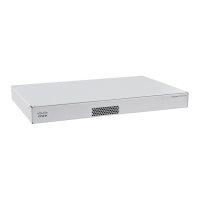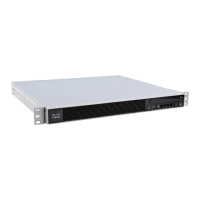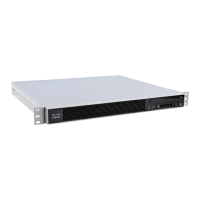1-73
Cisco ASA Series CLI Configuration Guide
Chapter 1 Configuring Connection Profiles, Group Policies, and Users
Group Policies
• none—When entered immediately after vpn-nac-exempt, this keyword disables inheritance and
specifies that all hosts will be subject to posture validation.When entered immediately after filter,
this keyword indicates that the entry does not specify an ACL.
• OS—Exempts an operating system from posture validation.
• os name—Operating system name. Quotation marks are required only if the name includes a space
(for example, “Windows XP”).
The following example adds all hosts running Windows XP to the list of computers that are exempt from
posture validation:
hostname(config-group-policy)# vpn-nac-exempt os "Windows XP"
hostname(config-group-policy)
The following example exempts all hosts running Windows 98 that match an ACE in the ACL named
acl-1:
hostname(config-group-policy)# vpn-nac-exempt os "Windows 98" filter acl-1
hostname(config-group-policy)
The following example adds the same entry to the exemption list, but disables it:
hostname(config-group-policy)# vpn-nac-exempt os "Windows 98" filter acl-1 disable
hostname(config-group-policy)
The following example removes the same entry from the exemption list, regardless of whether it is
disabled:
hostname(config-group-policy)# no vpn-nac-exempt os "Windows 98" filter acl-1
hostname(config-group-policy)
The following example disables inheritance and specifies that all hosts will be subject to posture
validation:
hostname(config-group-policy)# no vpn-nac-exempt none
hostname(config-group-policy)
The following example removes all entries from the exemption list:
hostname(config-group-policy)# no vpn-nac-exempt
hostname(config-group-policy)
Step 5 Enable or disable Network Admission Control by entering the following command:
hostname(config-group-policy)# nac {enable | disable}
hostname(config-group-policy)#
To inherit the NAC setting from the default group policy, access the alternative group policy from which
to inherit it, then use the no form of this command:
hostname(config-group-policy)# no nac [enable | disable]
hostname(config-group-policy)#
By default, NAC is disabled. Enabling NAC requires posture validation for remote access. If the remote
computer passes the validation checks, the ACS server downloads the access policy for the ASA to
enforce. NAC is disabled by default.
An Access Control Server must be present on the network.
The following example enables NAC for the group policy:
hostname(config-group-policy)# nac enable
hostname(config-group-policy)#

